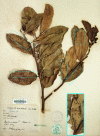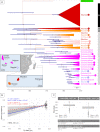First historical genome of a crop bacterial pathogen from herbarium specimen: Insights into citrus canker emergence
- PMID: 34324594
- PMCID: PMC8320980
- DOI: 10.1371/journal.ppat.1009714
First historical genome of a crop bacterial pathogen from herbarium specimen: Insights into citrus canker emergence
Abstract
Over the past decade, ancient genomics has been used in the study of various pathogens. In this context, herbarium specimens provide a precious source of dated and preserved DNA material, enabling a better understanding of plant disease emergences and pathogen evolutionary history. We report here the first historical genome of a crop bacterial pathogen, Xanthomonas citri pv. citri (Xci), obtained from an infected herbarium specimen dating back to 1937. Comparing the 1937 genome within a large set of modern genomes, we reconstructed their phylogenetic relationships and estimated evolutionary parameters using Bayesian tip-calibration inferences. The arrival of Xci in the South West Indian Ocean islands was dated to the 19th century, probably linked to human migrations following slavery abolishment. We also assessed the metagenomic community of the herbarium specimen, showed its authenticity using DNA damage patterns, and investigated its genomic features including functional SNPs and gene content, with a focus on virulence factors.
Conflict of interest statement
The authors have declared that no competing interests exist.
Figures






References
-
- Turner RS. After the famine: plant pathology, Phytophthora infestans, and the late blight of potatoes, 1845–1960. Hist Stud Phys Biol. 2005;35:341–70. doi: 10.1525/hsps.2005.35.2.341 - DOI
-
- FAO, IFAD, UNICEF, WFP & WHO. The state of food security and nutrition in the world—Building resilience for food and food security. Rome: FAO; 2017.
-
- Bernades MFF, Pazin M, Pereira LC, Dorta DJ. Impact of pesticides on environmental and human health. Toxicology studies: cells, drugs and environment. Rijeka, Croatia; 2015. pp.195–233.
Publication types
MeSH terms
Supplementary concepts
LinkOut - more resources
Full Text Sources
Molecular Biology Databases
Miscellaneous

